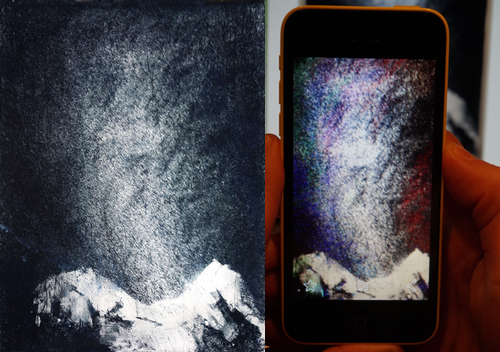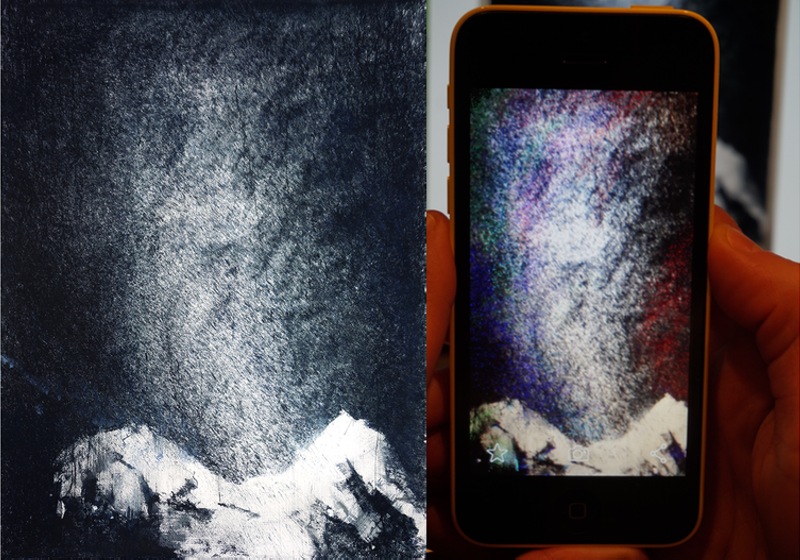Arts & Culture: Becoming One of the Team
Space exploration fascinates Ekaterina Smirnova, an artist based in New York who examines our place and impact on the Universe through various media. But not being a scientist, Smirnova was shut out of this enigmatic world. Most of her updates and information about new space discoveries came from tweets and posts on social media. That changed last year when Claudia Mignone, an astrophysicist turned science writer for the European Space Agency (ESA), reached out to her—Mignone had stumbled across Smirnova’s work while researching artwork inspired by ESA’s Rosetta space probe to a far-flung comet, and the two started communicating. Smirnova has since been assimilating into science research, attending conferences, chatting with professors, and even writing a paper. “Claudia is responsible for my connection with the science world,” said Smirnova. “She helped me a lot.”
Smirnova became enamored with Rosetta when, on November 12, 2014, its spacecraft Philae successfully landed on the comet 67P/Churyumov-Gerasimenko. Picking up her brushes, Smirnova started work on a series of watercolors inspired by photographs of this weirdly shaped hunk of rock and its vaporizing ice; two of these watercolors are on display at the Union Arts Center in Sparkill, New York, until Sunday, February 12, 2017, along with other paintings by Smirnova. One year later, Smirnova got an email from Mignone asking if her work could be included in an ESA directory of Rosetta-related art.
“It was a series of coincidences,” said Mignone, who had become curious about Rosetta-inspired art after a couple of artists had sent her team unsolicited links to their work. Mignone started googling and collating information about Rosetta artwork to share with ESA scientists and on social media, and she noticed Smirnova’s paintings. These were different from most of the poems, musical compositions, and other art that Mignone encountered. Smirnova wasn’t just presenting her interpretation of the comet; she was incorporating scientific discoveries and data into the art. “I really like the research process behind her work,” said Mignone.
Shortly after Philae’s touchdown, ESA scientists announced that the icy water on 67P was surprisingly different from water on Earth. Smirnova’s interest was piqued: Isn’t water just water? She delved into the underlying research and learned that the comet’s icy water had three times more deuterium than Earth’s water. Smirnova decided to “enrich” her paintings with this detail, swapping the New York tap water she normally uses with water that has the same composition as 67P’s. But the process wasn’t quite as simple as it sounds. It involved myriad electrolysis experiments that she set up in her studio and eventually the purchase of “extremely expensive” samples of pure heavy water. “It was pretty bizarre to my artist colleagues. I had to explain that the process was safe and that there was nothing to worry about,” said Smirnova. The water has absolutely no visual effect, but that was never Smirnova’s hope. Instead, by presenting scientific data in an artistic form, research findings can be shared more easily with nonscientists, who are “more likely to look at a painting than read a scientific poster.”
Smirnova was curious about other Rosetta-research findings, and Mignone’s contact provided the opening she needed to truly break into the science world and find out more. Mignone pointed Smirnova to the names of researchers who could answer her questions, and when a symposium on Rosetta research was announced, she suggested the artist take the “unconventional” step of submitting an abstract. Smirnova jumped at the opportunity: finally a chance to interact face-to-face with the people behind Rosetta. According to both Smirnova and Mignone, the symposium organizers were a bit “puzzled” when they received the abstract, but they gave Smirnova a poster slot, and her paintings went up on display around the conference room. “It was the first time I met any scientist,” said Smirnova. “They were all so open and willing to answer any of my questions.” Smirnova also published an article on her work after receiving an email inviting the symposium’s speakers to submit their research for publication.
The new interactions have enabled Smirnova to add “virtual layers” to the 67P paintings as she learns about new data. Using an augmented-reality app called Blippar, Smirnova has added spectroscopic data to the paintings that are made visible when the camera of a phone is focused on the paintings. The same app plays eerie clicks that were inspired by the comet’s journey around the Solar System, as well as by maps of the comet’s magnetic field. And the comet’s chemical composition can be sniffed from a postcard of one of the 67P paintings, available at her current exhibition. Hydrogen sulfide, ammonia, formaldehyde, methanol, and sulfur dioxide combine to create a pungent aroma with whiffs of cow manure, urine, and rotting eggs. It’s not a smell you want to breathe in deeply.
So far, no scientist has contacted Smirnova to ask her to make art from their data. But she is now in contact with scientists from all over the world whose research is constantly inspiring her. “The further I go, the more excited I get,” said Smirnova. “I just need to find enough time in the day to do all of this artwork.”
–Katherine Wright





